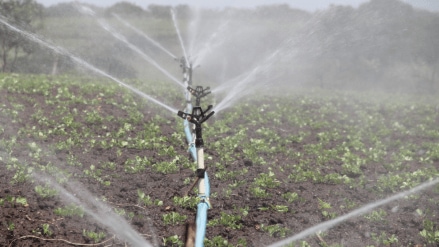By Saurabh Bandyopadhyay
In India’s agrarian landscape, the relationship between irrigation and cropping decisions has long been treated as linear, where expansion of irrigation infrastructure is expected to lead to changes in cropping patterns, particularly a shift toward more water-intensive and high-value crops. However, empirical evidence from the past decade suggests that this assumption does not hold uniformly. A closer analysis of national agricultural data from 2011-12 to 2022-23 reveals a more dynamic and contemporaneous relationship between irrigation and sowing decisions, with important implications for agricultural policy.
During this 11-year period, India saw a significant increase in both the gross irrigated area (GIA) and gross sown area (GSA). The GIA rose from 91.8 million hectares in 2011-12 to 122.3 million hectares by 2022-23. At the same time, the GSA grew from 195.8 to 219.4 million hectares. This expansion translated into a steady increase in the share of sown area under irrigation — from 46.9% to 55.8%. Crop yields also rose considerably, from 841 kg per acre in 2011-12 to 1,009 kg per acre in 2022-23, indicating an average annual growth rate of 1.67%. These changes suggest not only a quantitative expansion of irrigation but also its qualitative impact in enhancing land productivity.
An analysis of India’s data on total area under irrigation and GSA shows a strong link between the two. When irrigation coverage expanded, sowing activity also increased — especially when both happened in the same year. The connection weakened when there was a time gap between the two; in fact, a two-year lag in irrigation led to a negative relationship. This suggests that farmers typically decide on irrigation and cropping together, based on immediate conditions like rainfall, market prices, input availability, and policy cues — rather than following a fixed step-by-step process.
These findings challenge conventional wisdom in irrigation planning, where infrastructure projects are designed under the assumption that farmers will adapt their cropping choices once assured water becomes available. In practice, farmers make sowing decisions based on the water they can access now — not promises of supply two years into the future. This mismatch can result in underutilised irrigation assets and poor returns on public investment.
For irrigation policy to be effective, it must become more adaptive and time-sensitive. This means moving away from the dominant model of long-gestation, infrastructure-heavy investments that are disconnected from seasonal realities. Instead, irrigation planning and execution must be aligned with sowing calendars and agricultural time frames. Key interventions such as canal desilting, pump set repairs, and water release schedules should be implemented in tune with cropping windows.
Such agility requires institutional reforms. Decentralised governance should be at the heart of this shift. Local bodies, including water user associations and panchayati raj institutions, must be empowered with both autonomy and financial resources to deliver irrigation services suited to their regions. These bodies are best positioned to understand local agro-climatic nuances, cropping preferences, and water availability. A flexible, bottom-up approach will be more efficient and equitable than centrally managed, one-size-fits-all schemes.
Irrigation responsiveness also hinges on data. Real-time decision-making should be supported through better use of technology and information systems. Weather forecasts, soil moisture data, and remote sensing imagery can help predict water demand more accurately and guide allocation decisions. Digital platforms should be used to communicate timely advisories to farmers — ensuring they have the information to coordinate irrigation with other inputs.
Equally critical is input convergence. Farmers typically respond to an ecosystem of support, not just water access. Irrigation investments yield the best outcomes when paired with timely access to quality seeds, fertilisers, credit, and extension advice. Without this integration, irrigation expansion benefits are often muted.
Sustainability must remain a guiding principle in this transformation. While the data shows clear gains in irrigated area and yield, this expansion also places growing pressure on India’s water resources — particularly groundwater, which accounts for nearly two-thirds of total irrigation. The adoption of water-efficient technologies such as drip and sprinkler systems must be scaled up, particularly in water-stressed states. Policymakers should also use behavioural nudges — such as community water budgeting, transparent water accounting, and incentive-based water pricing — to encourage sustainable use.
The issue of cropping choices is also central to water sustainability. Continued reliance on water-intensive crops like paddy and sugarcane is ecologically costly. Encouraging a shift toward less water-consuming and more climate-resilient crops — such as millets, pulses, and oilseeds — can reduce irrigation demand while enhancing nutritional and income outcomes. This would require supportive procurement policies, market access, and awareness campaigns to change both farmer and consumer preferences.
The author is with NCAER.
Disclaimer: Views expressed are personal and do not reflect the official position or policy of FinancialExpress.com. Reproducing this content without permission is prohibited.
